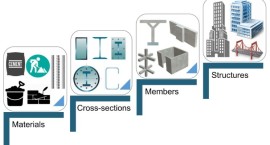
Structural Cross-sections: Analysis and Design
The cross-sections of structural members and their properties are a basic component in almost all aspects of analysis and design of structures. In fact, the primary objective of an efficient design process is to proportion the cross-sections of all structural elements to safely resist the applied load effects and actions. The cross-sectional properties are required a priori to even start the modeling and analysis process for a structure, to prepare initial cost estimates, and even to refine the basic space planning and utilization schemes. Is it then reasonable to conclude that the understanding of cross-sectional behavior of elements is the key to construct efficient, economic and resilient infrastructure? It seems that this may be the case.
The figure on the article header describes the short story of structural engineering, and shows the key position of cross-sections in the overall hierarchy of events involved in an efficient and smart transformation of “materials” in to “structures”. The properties of constituent materials manifest themselves in to the properties (e.g. stiffness and ductility) of cross-sections. The cross-sectional behavior then has a significant role in defining how the member will perform under an applied action/loading. Being an assemblage of individual members, the overall structural performance is determined by the member behavior.
This means that the response of any complex structure against applied loading can be traced back to its cross-sectional and material properties. Therefore, for an effective design of important structural components such as beams, columns and slabs, all issues related to the behavior of cross-sections and their properties need to be addressed in detail. Apart from structural aspects, the cross-sections of beams and columns also affect the planning and construction aspects of an engineering project. In planning context, they affect the space utilization, visibility, lateral clearance, water flow, wind resistance, aesthetics, etc. Similarly, the cross-section sizing and properties also affect rebar cage fabrication, formwork cost and its reuse, construction techniques, and efficiency. If one particular shape may be suitable from structural considerations, it may be unsuitable from planning or construction considerations.
The vital role of cross-sections in overall structural behavior, analysis and design also demands the development of integrated analysis approaches which should have the ability to handle all complex shapes, material behaviors and configurations. With the recent advancements in computing technologies and the applications of information technology in structural analysis and design, several computer-aided cross-section analysis packages are developed. The development of unified analysis procedures to determine axial-flexural capacities and response of cross-sections, is becoming even more important in this scenario.
The growing complexities in structural forms, architectural shapes and the use of materials with innovative properties, are some of the new challenges associated with the analysis of complex cross-sections (e.g. made of composite materials with significantly varying behaviors). For example, the determination of capacity for such a complex cross-section requires to determine stresses in individual constituent materials and then combine to get stress resultants. For a general cross-section, the flexural capacity also depends on the axial load. Due to this interaction of both actions (axial load and moment), we cannot simply determine the flexural capacity of a cross-section under uniaxial bending, as a constant number. Instead, an axial-load vs. moment interaction diagram (also referred to as capacity curve or yield curve) provides all possible combinations of both actions which would result in achievement of a pre-defined limit state. For a relatively more general case of biaxial bending, the axial-flexural capacity is defined by a 3D capacity/yield surface. This interaction of axial load and moment is an important consideration while setting-up a structural model for nonlinear analysis. For the determination of demand-to-capacity ratios for a cross-section against any loading scenario, its complete capacity curve should be defined prior to the detailed analysis.
Another (and perhaps the most important) relationship, showing the action-deformation behavior of a cross-section under flexural action, is the Moment-Curvature relationship. This relationship is the primary input in a nonlinear structural model as a load-deformation behavior assigned to a moment plastic hinge. This accounts for the nonlinear action assumed to be lumped at the location of plastic hinge. It describes the cumulative behavior of all materials and their properties as a combined cross-sectional response. Like any other action-deformation relationship, the moment-curvature curve is also described by different states, each corresponding to a physical condition of cross-section, starting from linear elastic behavior (uncracked) to near-collapse plastic behavior (fully damaged). The valuable insight obtained from the moment-curvature curve in terms of cross-sectional behavior (e.g. brittle, ductile, elasto-plastic, degrading etc.) can be used to predict the member response.
So it would seem that the cross-sectional properties of structural members are in fact the foundation of almost everything, starting from the determination of stiffness, stresses, and capacity, to the computation of response e.g. deflections, curvature and ductility. It is this key contribution of cross-sections that the retrofitting strategies for damaged structures are mainly comprised of increasing the load-carrying capacity and ductility of cross-sections of its members.
A recently published book “Structural Cross-sections: Analysis and Design” focusses on some of the key issues related to the understanding of cross-section behavior, with an emphasis on computer applications. It provides a consolidated and consistent information, insight and explanation of various aspects of cross-section response, analysis and design, irrespective of, but with due consideration to different materials. We hope that such attempts to integrate the textbook knowledge and theoretical concepts with the computer-aided analysis will contribute to better our understanding of structures, and will make the story for structural engineers more interesting, the story starting from “materials” and ending on “structures”.
Also available at Linked in:

